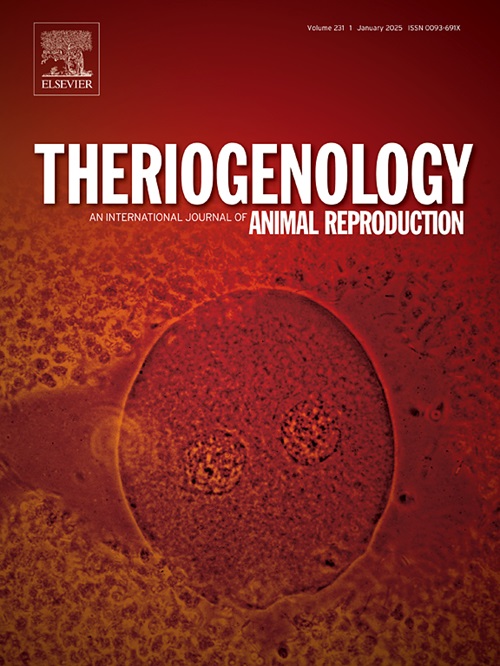妊娠后期热应激可引起奶牛胎盘的炎症反应,影响胎盘的营养转移特征
IF 2.4
2区 农林科学
Q3 REPRODUCTIVE BIOLOGY
引用次数: 0
摘要
哺乳动物胎儿在子宫内发育的条件对塑造其以后的生理功能至关重要。母体血液中营养物质、氧气和激素供应的变化会影响组织发育。我们假设妊娠后期热应激导致子叶组织中与急性炎症相关的基因表达改变,影响胎盘营养摄取机制,影响胎儿生长轨迹。在妊娠232±5天,已产荷斯坦奶牛终止泌乳(即干乳),随机分配到两种处理中的一种:冷却(CL;进入牲口棚的阴凉处,加上通过风扇和饲料通道上的渗水器强制通风,以提供主动蒸发冷却)或热应力(HT;在整个干燥期,他们都可以进入谷仓的阴凉处和自然通风(没有主动冷却)。在分娩前- 14天、- 7天和分娩时测量母体血浆皮质醇浓度(n = 28/trt)。分娩时,采集胎盘子叶组织样本并分析基因表达(n = 4-5 /trt)。在妊娠的最后几周,随着产犊的临近,治疗影响了血浆皮质醇浓度(p = 0.04),其中在- 14天,HT坝的血浆皮质醇浓度低于CL坝(9.65比13.09±1.5 ng/ml);p & lt;0.001)和分娩时(16.97∶22.32±1.4 ng/ml;p & lt;0.001),并伴有与急性炎症和皮质醇合成和分泌相关的胎盘基因通路的显著变化。具体来说,调节炎症的白介素-6 (il -6)和NLR家族pyrin domain-containing protein 3 (NLRP3)相关通路被HT上调,提示胎盘炎症。此外,由于HT下调了负责这些功能的关键基因,特别是丝氨酸生物合成,参与营养转移和氨基酸代谢的途径也受到了损害。这些发现表明,妊娠后期HT导致母体血浆皮质醇分泌模式失调,导致HT动物皮质醇水平降低。此外,它还引起胎盘炎症,影响胎母转移,突出妊娠后期对胎儿发育和管理乳制品生产中母体环境压力源的重要性。本文章由计算机程序翻译,如有差异,请以英文原文为准。
Late gestation heat stress induces inflammation and impacts nutrient transfer signature in the placenta of dairy cows
The conditions within the uterus where a mammalian fetus develops are crucial in shaping its physiological functions later in life. Changes in the availability of nutrients, oxygen, and hormones in the maternal blood stream can influence tissue development. We hypothesized that late gestation heat stress leads to alterations in gene expression in the cotyledonary tissue related to acute inflammation and impact the mechanisms of placental nutrient uptake, affecting the trajectory of fetal growth. Multiparous pregnant Holstein cows had lactation terminated (i.e. dried-off) at 232 ± 5 days of gestation and were randomly assigned to one of two treatments: cooling (CL; access to the shade of a barn plus forced ventilation via fans and water soakers over the feed lane to provide active evaporative cooling) or heat-stress (HT; access to the shade of a barn and natural ventilation, no active cooling) for the entire duration of their dry period. Maternal plasma (n = 28/trt) cortisol concentrations were measured at days −14, −7 prior to and at parturition. At delivery, placental cotyledonary tissue samples were collected and analyzed for gene expression (n = 4–5/trt). During the final weeks of gestation, treatment impacted plasma cortisol concentrations as calving approached (p = 0.04), wherein HT dams exhibited lower plasma cortisol concentrations than CL dams at −14 days (9.65 vs. 13.09 ± 1.5 ng/ml; p < 0.001) and at parturition (16.97 vs. 22.32 ± 1.4 ng/ml; p < 0.001), combined with significant changes in placental gene pathways associated with acute inflammation and cortisol synthesis and secretion. Specifically, pathways related to interleukin-6 (IL6) and NLR family pyrin domain-containing protein 3 (NLRP3), which regulate inflammation, were upregulated by HT, suggesting placental inflammation. Additionally, pathways involved in nutrient transfer and amino acid metabolism were impaired, as HT downregulated key genes responsible for these functions, especially serine biosynthesis. These findings indicate that HT during late gestation leads to dysregulation of cortisol secretion pattern in maternal plasma, resulting in reduced cortisol levels in the HT animals. Additionally, it also caused placental inflammation impacting feto-maternal transfers, highlighting the importance of late gestation period on fetal development and managing maternal environmental stressors in dairy production.
求助全文
通过发布文献求助,成功后即可免费获取论文全文。
去求助
来源期刊

Theriogenology
农林科学-生殖生物学
CiteScore
5.50
自引率
14.30%
发文量
387
审稿时长
72 days
期刊介绍:
Theriogenology provides an international forum for researchers, clinicians, and industry professionals in animal reproductive biology. This acclaimed journal publishes articles on a wide range of topics in reproductive and developmental biology, of domestic mammal, avian, and aquatic species as well as wild species which are the object of veterinary care in research or conservation programs.
 求助内容:
求助内容: 应助结果提醒方式:
应助结果提醒方式:


